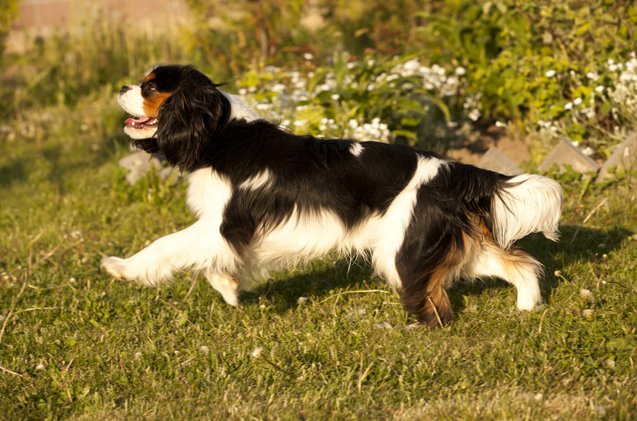Cavalier King Charles Spaniel


About Cavalier King Charles Spaniel
A somewhat recognizable breed that is growing more popular in the United States, the Cavalier King Charles Spaniel is a unique breed of toy dog that has already been popular in such dog-loving countries as the United Kingdom. But what’s in a name, really? After all, a breed that goes by the term Cavalier King Charles Spaniel really has to deliver on a lot of promises that its name makes: is this breed really such a noble animal that it should be named after a king?
Well, that’s always up for each individual dog owner to decide, but if you’re like us, you think the Cavalier King Charles Spaniel is one of the most ideal pet breeds available today. Although their popularity still has room for improvement here in North America, there are plenty of Cavalier King Charles Spaniel owners overseas who are perfectly content with the type of dog and household friend they’ve found in this breed.
Often white and brown with a smaller frame but a friendly disposition, the Cavalier King Charles Spaniel is really one of the ideal pets for domestic life. But you’re about to learn a lot more of this breed, including the answer to one crucial question: might this be the dog breed for you and your family?
The Cavalier King Charles Spaniel is one of the most ideal pet breeds available today.
As you might imagine from the name, the Cavalier King Charles Spaniel traces its roots back to royalty. In England, King Charles II was known for his “little dogs” and clearly had a preference for toy group-type breeds. There is even a legend that the King issued an edict that the Cavalier King Charles Spaniel-type dog could not be denied entrance to any public place – a high honor indeed, if it is true.
From that information alone, you can guess that the Cavalier King Charles Spaniel has been around in Europe for several hundred years, although it has not always been the most popular of toy breeds. Believe it or not, the pug was popular in Northern Europe at around the time of the 17th century.
Ultimately, it’s been up to the 19th and 20th centuries to rebuild the Cavalier King Charles Spaniel breed, using old paints as a template, as some of their heritage had been lost during the breeding of the past few hundred years. These days, you can find a Cavalier King Charles Spaniel frequently in England and the United Kingdom in general, and an ever-increasing amount in the United States.
The Cavalier King Charles Spaniel finds its pedigree with a number of dogs because of its slightly odd breeding history. The original Cavalier King Charles Spaniels were around and had been bred from other toy dogs and spaniels during the 16th century or so, but modern day breeders have been using other methods of breeding to bring a more pure version of the Cavalier King Charles Spaniel back into existence.
As a toy breed, the Cavalier King Charles Spaniel doesn’t have a necessarily large diet compared to other dogs, but it’s important to remember that it is one of the heaviest and largest toy breeds in existence. A full, lustrous coat will require good nutrition and care, so be sure to feed your dog good whole foods like meat and vegetables in addition to a normal dog diet of kibbles and treats.
As you might imagine from the name, the Cavalier King Charles Spaniel traces its roots back to royalty.
These dogs are very friendly and known for being patient, and their eagerness to please is considered a plus for dog trainers who don’t have a lot of experience in shaping a dog’s behavior. This is great news if you’re new to the world of dog training and could really use an easier dog to handle.
A weight of 10-18 pounds makes this a relatively large toy breed, and suggests its heritage as a dog bred for being comfortable on your lap. About 10-18 pounds is actually a high degree of variance, so just be sure that your dog appears to have a weight proportional to its general build and height.
Ideal for a life with children and in neighborhoods with other dogs, the temperament of the Cavalier King Charles Spaniel is just about as good as you’ll find for a companion dog. It won’t necessarily make a great or aggressive guard dog, but it will get along with your children and other dogs just fine.
Cavalier King Charles Spaniels do have some problems with health, particularly in the world of genetic diseases. For example, almost all Cavalier King Charles Spaniels eventually run into heart trouble s in the form of Mitral valve disease, a disease that can eventually lead to heart failure down the line. Syringomyelia is another disease that affects the Cavalier King Charles Spaniel worse than in other dogs and since it affects the spine and brain; it can be a particularly difficult one for your dog to endure.
A life expectancy of around 9 to 14 years should be expected, with the high degree of variance explained by the breed’s propensity to a number of health problems and hereditary diseases.
Lively dogs, the Cavalier King Charles Spaniels will require good daily exercise and enjoy a good amount of play – you may find it to be a difficult dog to wear out if you aren’t ready for it.
These dogs are very friendly and known for being patient, and their eagerness to please is considered a plus.
The American Kennel Club rates the Cavalier King Charles Spaniel as an “elegant, energetic toy breed that is compatible for city or country life.”
A longer coat that can have a really great shine and attractive look means that you’ll want to go the extra mile to ensure the coat is taken care of and groomed properly.
Puppies
Since Cavalier King Charles Spaniels are easy to train, raising one from a puppy should not prove to be a too difficult challenge to manage. Setting basic expectations and boundaries for the puppy is advisable as it would be for a dog of any breed.
Photo credit: Liliya Kulianionak/Shutterstock

Amy Tokic, Editor of PetGuide.com, is a passionate animal lover and proud pet parent of Oscar, a Shih Tzu/Chihuahua cross, and Zed, a Japanese Chin. Her love of animals began in kindergarten, when she brought her stuffed dog Snoopy into class with her every day. Now, she writes about her adventures in pet ownership and tirelessly researches products, news and health related issues she can share with other animal enthusiasts. In her free time, Amy loves perusing used book and record stores, obsessing over the latest pet products available and chasing squirrels with wild abandon (a habit attributed to spending too much time with her pooches).
More by Amy Tokic
























